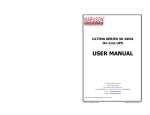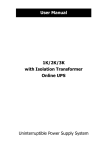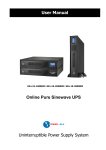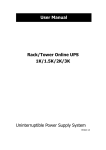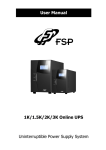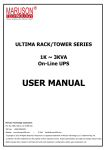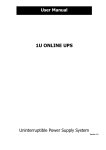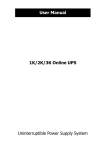Download 5K online UPS Uninterruptible Power Supply System User Manual
Transcript
User Manual 5K online UPS Uninterruptible Power Supply System Table of Contents 1. Important Safety Warning ................................................................................... 2 1-1. Transportation .................................................................................................... 2 1-2. Preparation ........................................................................................................ 2 1-3. Installation ......................................................................................................... 2 1-4. Operation ........................................................................................................... 3 1-5. Maintenance, service and faults ........................................................................... 3 2. Installation and setup .......................................................................................... 4 2-1. Rear panel view.................................................................................................. 4 2-2. Install the UPS ................................................................................................... 4 3. Operations ............................................................................................................ 7 3-1. Button operation ................................................................................................ 7 3-2. LCD Panel .......................................................................................................... 7 3-3. Audible Alarm ..................................................................................................... 9 3-4. LCD display wordings index ................................................................................. 9 3-5. UPS Setting ........................................................................................................ 9 3-6. Operating Mode Description .............................................................................. 12 3-7. Faults Reference Code....................................................................................... 13 3-8. Warning indicator ............................................................................................. 13 4. Storage and Maintenance ................................................................................... 14 5. Specifications ..................................................................................................... 15 1 1. Important Safety Warning Please comply with all warnings and operating instructions in this manual strictly. Save this manual properly and read carefully the following instructions before installing the unit. Do not operate this unit before reading through all safety information and operating instructions carefully. 1-1. Transportation Please transport the UPS system only in the original package to protect against shock and impact. 1-2. Preparation Condensation may occur if the UPS system is moved directly from cold to warm environment. The UPS system must be absolutely dry before being installed. Please allow at least two hours for the UPS system to acclimate the environment. Do not install the UPS system near water or in moist environments. Do not install the UPS system where it would be exposed to direct sunlight or near heater. Do not block ventilation holes in the UPS housing. 1-3. Installation To guarantee UPS normal operation, before connecting devices to the UPS, please verify that ground and neural lines of the connected devices are not short circuited. (see figure 1) Figure 1 If neutral line and ground line are short circuited, please add isolation transformer between UPS and devices. (see figure 2) Figure 2 Do not connect appliances or devices which would overload the UPS system (e.g. laser printers) to the UPS output sockets. Place cables in such a way that no one can step on or trip over them. Do not connect domestic appliances such as hair dryers to UPS output sockets. 2 The UPS can be operated by any individuals with no previous experience. Connect the UPS system only to an earthed shockproof outlet which must be easily accessible and close to the UPS system. 1-4. Operation Do not disconnect the mains cable on the UPS system or the building wiring outlet (shockproof socket outlet) during operations since this would cancel the protective earthing of the UPS system and of all connected loads. The UPS system features its own, internal current source (batteries). The UPS output sockets or output terminals block may be electrically live even if the UPS system is not connected to the building wiring outlet. In order to fully disconnect the UPS system, first press the OFF/Enter button to disconnect the mains. Prevent no fluids or other foreign objects from inside of the UPS system. 1-5. Maintenance, service and faults The UPS system operates with hazardous voltages. Repairs may be carried out only by qualified maintenance personnel. Caution - risk of electric shock. Even after the unit is disconnected from the mains (building wiring outlet), components inside the UPS system are still connected to the battery and electrically live and dangerous. Before carrying out any kind of service and/or maintenance, disconnect the batteries and verify that no current is present and no hazardous voltage exists in the terminals of high capability capacitor such as BUS-capacitors. Only persons are adequately familiar with batteries and with the required precautionary measures may replace batteries and supervise operations. Unauthorized persons must be kept well away from the batteries. Caution - risk of electric shock. The battery circuit is not isolated from the input voltage. Hazardous voltages may occur between the battery terminals and the ground. Before touching, please verify that no voltage is present! Batteries may cause electric shock and have a high short-circuit current. Please take the precautionary measures specified below and any other measures necessary when working with batteries: -remove wristwatches, rings and other metal objects -use only tools with insulated grips and handles. When changing batteries, install the same number and same type of batteries. Do not attempt to dispose of batteries by burning them. This could cause battery explosion. Do not open or destroy batteries. Escaping electrolyte can cause injury to the skin and eyes. It may be toxic. Please replace the fuse only with the same type and amperage in order to avoid fire hazards. Do not dismantle the UPS system. 3 2. Installation and setup NOTE: Before installation, please inspect the unit. Be sure that nothing inside the package is damaged. Please keep the original package in a safe place for future use. 2-1. Rear panel view 1. Programmable outlets: connect to non-critical loads. 2. Output terminal 3. Input terminal 4. Network/Fax/Modem surge protection 5. USB communication port 6. RS-232 communication port 7. Intelligent slot 8. Emergency power off function connector (EPO) 2-2. Install the UPS For safety consideration, the UPS is shipped out from factory with the main switch off. Before installing the UPS, please follow below steps to activate the UPS first. Step 1 Step 2 Press the main switch to activate the UPS. Remove front panel. Press the main switch to activate the UPS. 4 Press again to inactivate the UPS. Step 3 Put the front panel back to the unit. Rack-mount Installation Step 1 Tower Installation Step 1 Step 2 Step 2 Step 3 Step 1: UPS input connection Plug the UPS into a two-pole, three-wire, and grounded receptacle only. Please do not use extension cords. The input plug is #12*3C. Step 2: UPS output connection Simply plug devices to output sockets. During power failure, UPS will provide power to connected devices. 5 Step 3: Communication connection Intelligent slot This model is equipped with intelligent slot perfect for SNMP, RS-232, USB or AS-400 card. When installing with these communication card in the UPS, it will provide advanced communication and monitoring options. Step 1: Remove cover of intelligent slot. Step 2: Insert communication card into the slot Step 3: Screw card tightly and complete installation. Step 4: Turn on the UPS Be sure to press the main switch to activate the UPS first before turning on the UPS. Then, press the ON/Mute button on the front panel for two seconds to power on the UPS. Important!! Only operate main switch for initial usage or long-term storage. Note: The battery charges fully during the first five hours of normal operation. Do not expect full battery run capability during this initial charge period. Step 5: Install software For optimal computer system protection, install UPS monitoring software to fully configure UPS shutdown. You may insert provided CD into CD-ROM to install the monitoring software. If not, please follow steps below to download and install monitoring software from the internet: 1. Go to the website http://www.power-software-download.com 2. Click ViewPower software icon and then choose your required OS to download the software. 3. Follow the on-screen instructions to install the software. 4. When your computer restarts, the monitoring software will appear as an orange plug icon located in the system tray, near the clock. 6 3. Operations 3-1. Button operation Button Function Turn on the UPS: Press and hold ON/Mute button for at least 2 seconds to turn on the UPS. Mute the alarm: After the UPS is turned on in battery mode, press and hold this button for at least 5 seconds to disable or enable the alarm system. But it’s not applied to the situations when warnings or ON/Mute Button errors occur. Up key: Press this button to display previous selection in UPS setting mode. Switch to UPS self-test mode: Press ON/Mute buttons simultaneously for 5 seconds to enter UPS self-testing while in AC mode or converter mode. Turn off the UPS: Press and hold this button at least 2 seconds to turn off the UPS in battery mode. UPS will be in standby mode under power normal or transfer to Bypass mode if the Bypass enable setting OFF/Enter Button by pressing this button. Confirm selection key: Press this button to confirm selection in UPS setting mode. Switch LCD message: Press this button to change the LCD message for input voltage, input frequency, battery voltage, output voltage and output frequency. It will return back to default display when pausing for 10 seconds. Select Button Setting mode: Press and hold this button for 5 seconds to enter UPS setting mode when UPS is in standby mode or bypass mode. Down key: Press this button to display next selection in UPS setting mode. Switch to bypass mode: When the main power is normal, press ON/Mute + Select ON/Mute and Select buttons simultaneously for 5 seconds. Then UPS Button will enter to bypass mode. This action will be ineffective when the input voltage is out of acceptable range. 3-2. LCD Panel 7 Display Input Information Function Indicates the AC input voltage, AC input frequency, battery voltage, battery discharge/charge current, and ambient temperature. Setting programs, error codes and backup time information Indicates the estimated backup time. H: hours, M: minute Indicates the setting programs and the detailed settings are listed in section 4. Indicates warning and fault codes and detailed codes are listed in section 7 and 8. Output information Indicate the output voltage, output frequency, load level, load in VA, and load in Watt. Battery information Indicates battery level (by 0-24%, 25-49%, 50-74%, and 75-100%), charging status and battery type (by SLA, Li). SLA: sealed lead acid battery ; Li: Li battery Load information Indicates overload. Indicates the load level by 0-24%, 25-50%, 50-74%, and 75-100%. Mode operation information Indicates the UPS connects to the mains. Indicates the bypass circuit is working. Indicates the ECO mode is enabled. Indicates the PFC circuit is working. Indicates the inverter circuit is working. Mute operation Indicates that the UPS alarm is disabled. Programmable outlets information Indicates that programmable outlets are working. 8 3-3. Audible Alarm Battery Mode Sounding every 4 seconds Low Battery Sounding every second Overload Sounding twice every second Fault Continuously sounding Bypass Mode Sounding every 10 seconds 3-4. LCD display wordings index Abbreviation Display content Meaning ENA Enable DIS Disable ESC Escape HLS High loss LLS Low loss EP Emergency power off TP Temperature CH Charger BF Battery fault BR Battery replace ON ON FU Bypass frequency unstable 3-5. UPS Setting Parameter 2 Parameter 1 Parameter 3 There are three parameters to set up the UPS. Parameter 1: It’s for program alternatives. Refer to below table for detailed setting programs. Parameter 2 and parameter 3 are the setting options or values for each program. 9 00: Exit Interface Setting Exit UPS setting 01: Output voltage setting Interface Setting Parameter 3: Output voltage You may choose the following output voltage by pressing On/Mute (up-key) or Select (down-key) button. Then, press enter-key to confirm the selected output voltage. 220: presents output voltage is 220Vac 230: presents output voltage is 230Vac 240: presents output voltage is 240Vac 02: Acceptable input voltage range Interface Setting Parameter 2 & Parameter 3: Set acceptable high voltage point and low voltage point for Line mode by pressing On/Mute (up-key) or Select (down-key) button. HLS: High loss voltage in Line mode in parameter 3. For 220/230/240 VAC models, the setting range is from 260V to 280V. LLS: Low loss voltage in Line mode in parameter 3. For 220/230/240 VAC models, the setting range is from 170V to 190V. 03: ECO enable/disable Interface Setting Parameter 3: Enable or disable ECO function by pressing On/Mute (up-key) or Select (down-key) button. Then, press enter-key to confirm selection. ENA: ECO mode is enabled. DIS: ECO mode is disabled. 04: ECO voltage range setting Interface Setting Parameter 2 & Parameter 3: Set acceptable high voltage point and low voltage point for ECO mode by pressing On/Mute (up-key) or Select (down-key) button. HLS: High loss voltage in ECO mode in parameter 3. For 220/230/240 VAC models, the setting range is from +7V to +24V of the nominal voltage. LLS: Low loss voltage in ECO mode in parameter 3. For 220/230/240 VAC models, the setting range is from -7V to -24V of the nominal voltage. 10 05: Bypass mode enable/disable when UPS is off Interface Setting Parameter 3: Bypass mode enable/disable when UPS is off and the mains is ok. ENA: Bypass mode is enabled and there is output from UPS even though the UPS is off, but the mains is ok. DIS: Bypass mode is disabled and there is no output from UPS even though the mains is ok. 06: Bypass voltage range setting Interface Setting Parameter 2 & Parameter 3: Set acceptable high voltage point and low voltage point for bypass mode by pressing On/Mute (up-key) or Select (down-key) button. HLS: High loss voltage in Bypass mode in parameter 3. For 220/230/240 VAC models, the setting range is from 230Vac to 264Vac. LLS: Low loss voltage in Bypass mode in parameter 3. For 220/230/240 VAC models, the setting range is from 170Vac to 220Vac. 07: Bypass frequency range setting Interface Setting Parameter 2 & Parameter 3: Set acceptable high frequency point and low frequency point for Bypass mode by pressing On/Mute (up-key) or Select (Down-key) button. HLS: High frequency point in Bypass mode in parameter 3. For 50Hz models, the setting range is from 51.0Hz to 55.0Hz. LLS: Low frequency point in Bypass mode in parameter 3. For 50Hz models, the setting range is from 45.0Hz to 49.0Hz. 08: Programmable outlets enable/disable Interface Setting Parameter 3: Enable or disable programmable outlets. ENA: Programmable outlets are enabled. DIS: Programmable outlets are disabled. 09: Programmable outlets setting Interface Setting Parameter 3: Set up backup time limits for programmable outlets. 0-999: setting the backup time limits in minutes from 0-999 for programmable outlets which connect to non-critical devices on battery mode. 11 10: Backup time setting for outlets Interface Setting Parameter 3: Set up backup time on battery mode for general outlets. 0-999: setting the backup time in minutes from 0-999 for general outlets on battery mode. 0: When setting as “0”, the backup time will be only 10 seconds. 999: When setting as “999”, the backup time setting will be disabled. 3-6. Operating Mode Description Operating mode Description LCD display Online mode When the input voltage is within acceptable range, UPS will provide pure and stable AC power to output. The UPS will also charge the battery at online mode. ECO mode Energy saving mode: When the input voltage is within voltage regulation range, UPS will bypass voltage to output for energy saving. Battery mode When the input voltage is beyond the acceptable range or power failure and alarm is sounding every 4 second, UPS will backup power from battery. Bypass mode When input voltage is within acceptable range but UPS is overload, UPS will enter bypass mode or bypass mode can be set by front panel. Alarm is sounding every 10 second. Standby mode UPS is powered off and no output supply power, but still can charge batteries. 12 3-7. Faults Reference Code Fault event Fault code Bus start fail 01 Bus over 02 Bus under 03 Bus unbalance 04 Inverter soft start fail 11 Inverter voltage high 12 Icon x x x x x x Fault event Inverter voltage Low Inverter output short Battery voltage too high Battery voltage too low Over temperature Over load Icon (flashing) Alarm Fault code 13 14 27 28 41 43 3-8. Warning indicator Warning Low Battery Sounding every second Overload Sounding twice every second Sounding every second Battery is not connected Battery Replace Sounding every 2 second Over Charge Sounding every second EPO enable Sounding every second Over temperature Sounding every second Charger failure Sounding every second Out of bypass voltage range Sounding every second 13 Icon x x x x x 4. Storage and Maintenance Operation The UPS system contains no user-serviceable parts. If the battery service life (3 years at 25°C ambient temperature) has been exceeded, the batteries must be replaced. In this case, please contact your dealer. Be sure to deliver the spent battery to a recycling facility or ship it to your dealer in the replacement battery packing material. Storage Before storing, charge the UPS 2 hours. Store the UPS covered and upright in a cool, dry location. During storage, recharge the battery in accordance with the following table: Storage Temperature Recharge Frequency Charging Duration -25°C - 30°C Every 4 months 2 hours 30°C - 45°C Every 1 month 2 hours 14 5. Specifications Capacity 5000VA/4500W INPUT Voltage Range Low Line Transfer 170VAC ± 5 % Low Line Comeback 180VAC ± 5 % High Line Transfer 280VAC ± 5 % High Line Comeback Frequency Range 270VAC ± 5 % 40 ~ 70 Hz(Auto sensing) Phase single phase L,N,G (Terminal) Power Factor 0.95 up to 0.99 @ 170-260Vac OUTPUT Output Voltage 220/230/240 VAC AC Voltage Regulation (Batt. Mode) ± 1% Frequency Range (Synchronized Range) 47 ~ 53 Hz or 57 ~ 63 Hz Frequency Range (Batt. Mode) 50 Hz ± 0.2 Hz or 60Hz ± 0.2 Hz Current Crest Ratio (CF) 3:1 ≦ 3% THD (Linear load) Harmonic Distortion (THDU) Transfer Time 6% THD (Non-linear Load) AC Mode to Batt. Mode Zero Inverter to Bypass 4 ms (Typical) Waveform (Batt. Mode) Pure Sinewave Phase single phase L,N,G (Terminal) EFFICIENCY 92% peak(50-100% of full RCD load) AC Mode Battery Mode(@ 100% of full RCD load) 90% peak (during battery autonomy) BATTERY Battery Type Li battery Battery Voltage Backup Time 102V 4 min. @ 100% load / 6 min. @ 80% load Typical Recharging Time 2 hours recovers to 90% capacity PHYSICAL Dimension, D X W X H (mm) 600 x 438 x 88 Net Weight (kgs) 21 ENVIRONMENT Humidity Noise Level 0-95 % RH @ 5- 40°C (non-condensing) Less than 55dBA @ 1 Meter & around UPS with less than 80% Load MANAGEMENT Smart RS-232 or USB Optional SNMP Supports Windows 2000/2003/XP/Vista/2008/7, Linux, Unix, and MAC Power management from SNMP manager and web browser 15

















